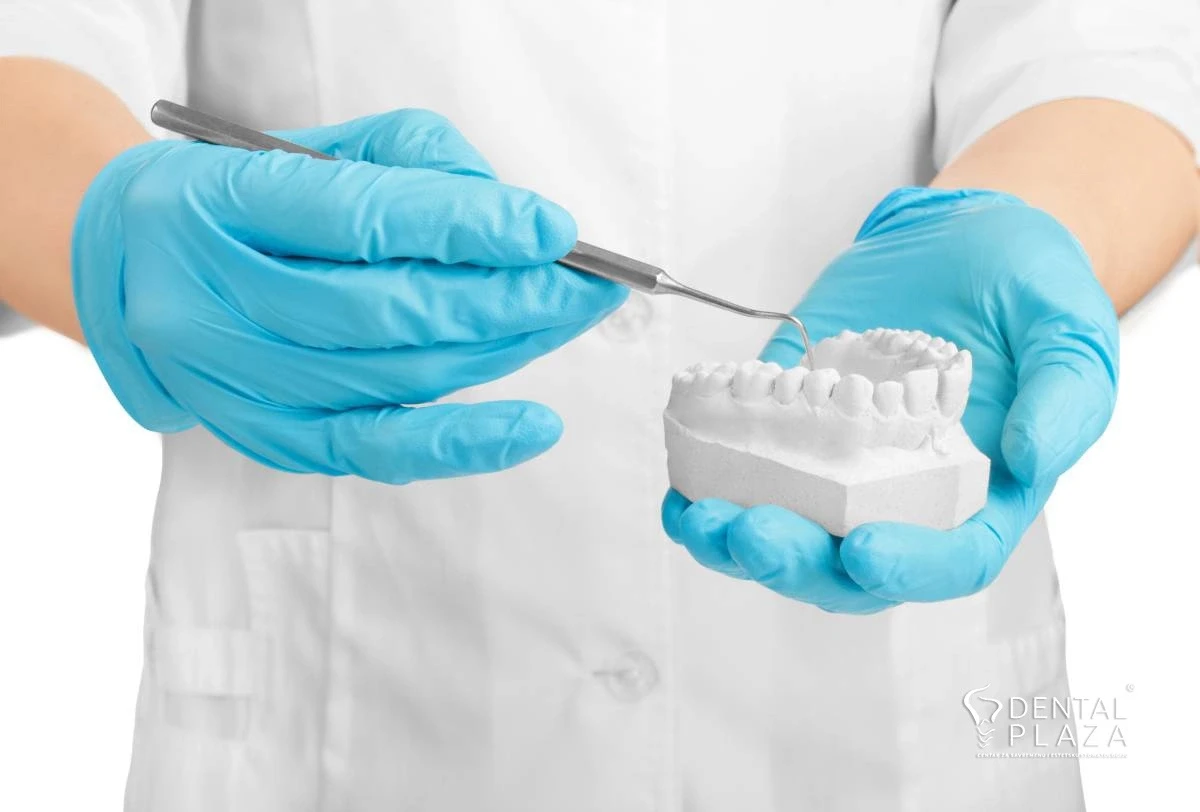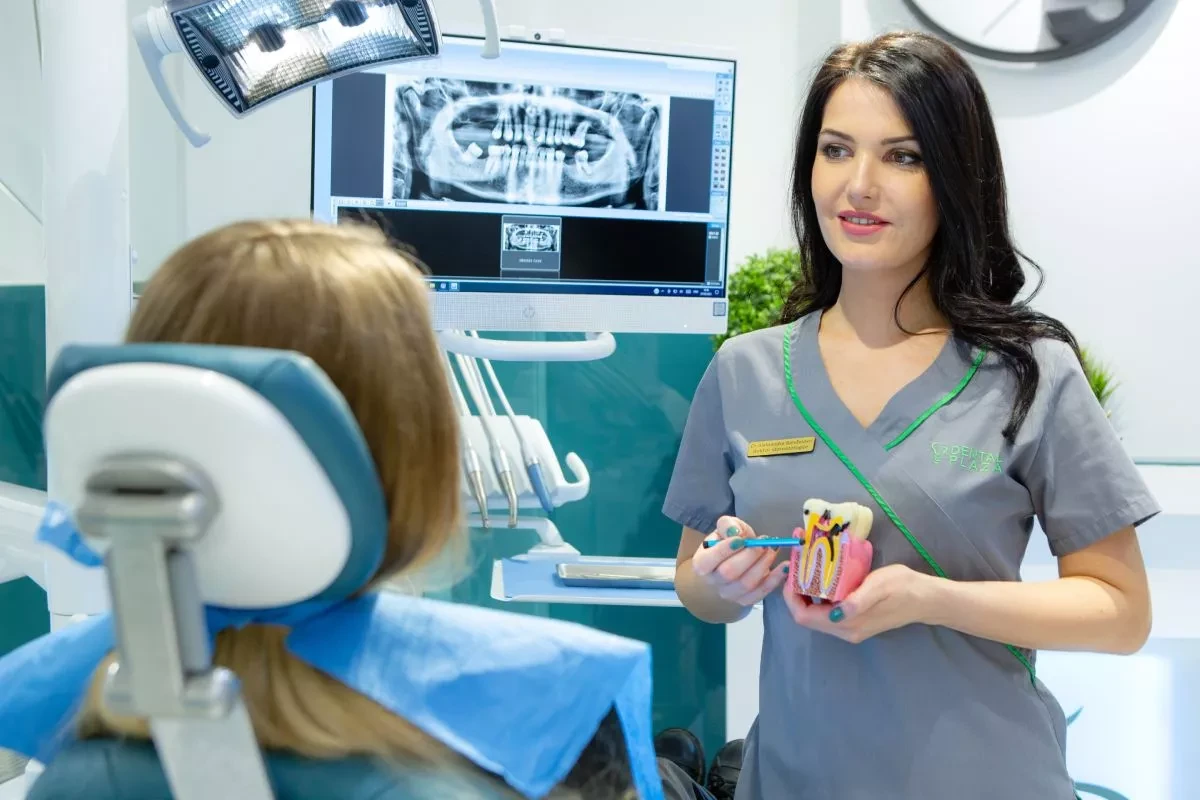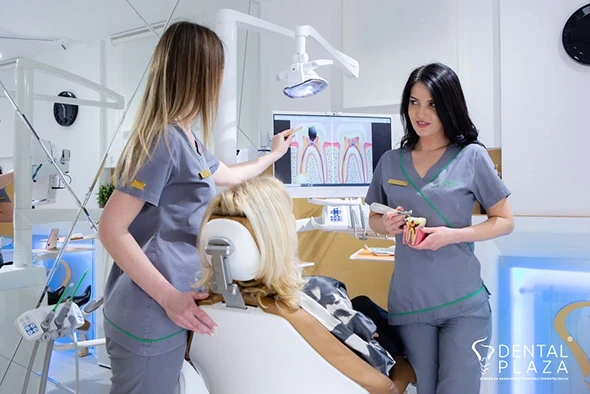Do not be shy, show your teeth!
Call Center 08-21h
Do not be shy, show your teeth!
Call Center 08-21h

Dental prosthetics is one of the branches of dentistry dealing with the replacement of lost teeth using various techniques, materials and replacements.
The two major branches of dental prosthetics are: mobile prosthetics and fixed prosthetics. As part of mobile prosthetics, different types of dentures are made that the patient can remove himself. Fixed prosthetic works mean crowns and bridges fixed to teeth or to implants.
By making prosthetic restorations, the function of the oral apparatus, which is lost or impaired by the loss of teeth, is replaced. Also, it is very important to note that prosthetic restorations can have highly aesthetic characteristics, which is an increasingly common reason why patients decide to have them made.
The development of dental prosthetics offers numerous possibilities, so a solution can be easily found for each patient, depending on the individual situation. Just some of the prosthetic restorations that you can do in our office are:
1. Zirconium ceramic crowns - Zirconium crowns or bridges are a more modern solution than metal-ceramic ones, because zirconium is used instead of metal to support the crown. Zirconium is one of the hardest materials and is primarily used in space technologies. It is completely biocompatible with the body, so zirconium crowns do not cause any kind of allergic reactions. In the process of manufacturing zirconium ceramic crowns, modern technology is used, which includes computer scanning of impressions and micron precision during manufacturing. Zirconium crowns can be made on teeth as well as on implants.

2. Metal-ceramic crowns - When it comes to crowns, metal-ceramics have always been at the forefront of application throughout the history of dentistry. Metal-ceramic crowns, as the word itself suggests, basically have metal, and ceramic layers are applied over it. Metal ceramic is durable, so it is a suitable material for modeling the shape, but also for bringing the color in harmony with the rest of the dental row. Adding to their greater prevalence is that they are older and have been chosen as the default much more often. Most crowns of this type serve as a functional tooth, but they also fit in with the existing teeth aesthetically. They also can be made on teeth and implants.
3. Ceramic veneers - Veneers (facets) are thin flakes made of different materials that are adapted to the front surface of the teeth. They can be used to correct the color, shape and size of the teeth. Veneers are made from ceramics that are extremely resistant and strong in a very thin layer, so one of the main advantages of veneers compared to crowns is that minimal tooth substance is removed for their production.
4. Gold-ceramic crowns - The basis of these crowns is gold (instead of classic metal alloys), and aesthetics are replaced with ceramics, that is, with ceramics, the tooth acquires the color and appearance of a natural tooth. These are superb and exclusive prosthetic works.
5. Total dentures - A total denture is a prosthetic replacement made for edentulous patients, i.e. in situations where there are no teeth in the jaw. The total denture rests on the gums, covers the alveolar ridge and compensates for lost teeth. These restorations are most often made of acrylic, and teeth made of the same material are also placed on them.

6. Partial dentures - A partial denture is a prosthetic replacement that compensates for lost teeth, and is fixed to the remaining teeth using a hook. This is the main difference between partial and total dentures. It is used as a compensation in edentulous patients. A partial denture rests on the gums, covers the alveolar ridge and compensates for lost teeth. All dentures are made mobile, which means that they can and must be removed from the mouth primarily due to proper maintenance of oral hygiene.
7. Dentures on implants - Total dentures on implants are the therapy of choice for edentulous patients who have difficulties in stabilizing their dentures, chewing problems, who are disgusted by dentures, and simply cannot and should not be without them. This combination ensures that the prosthesis in the lower jaw does not move, provides safety in chewing food, but also in aesthetics. Dentures on implants are becoming an increasingly common choice for our patients.
Do you have questions?

Dental prosthetics is one of the branches of dentistry dealing with the replacement of lost teeth using various techniques, materials and replacements.
The two major branches of dental prosthetics are: mobile prosthetics and fixed prosthetics. As part of mobile prosthetics, different types of dentures are made that the patient can remove himself. Fixed prosthetic works mean crowns and bridges fixed to teeth or to implants.
By making prosthetic restorations, the function of the oral apparatus, which is lost or impaired by the loss of teeth, is replaced. Also, it is very important to note that prosthetic restorations can have highly aesthetic characteristics, which is an increasingly common reason why patients decide to have them made.
The development of dental prosthetics offers numerous possibilities, so a solution can be easily found for each patient, depending on the individual situation. Just some of the prosthetic restorations that you can do in our office are:
1. Zirconium ceramic crowns - Zirconium crowns or bridges are a more modern solution than metal-ceramic ones, because zirconium is used instead of metal to support the crown. Zirconium is one of the hardest materials and is primarily used in space technologies. It is completely biocompatible with the body, so zirconium crowns do not cause any kind of allergic reactions. In the process of manufacturing zirconium ceramic crowns, modern technology is used, which includes computer scanning of impressions and micron precision during manufacturing. Zirconium crowns can be made on teeth as well as on implants.

2. Metal-ceramic crowns - When it comes to crowns, metal-ceramics have always been at the forefront of application throughout the history of dentistry. Metal-ceramic crowns, as the word itself suggests, basically have metal, and ceramic layers are applied over it. Metal ceramic is durable, so it is a suitable material for modeling the shape, but also for bringing the color in harmony with the rest of the dental row. Adding to their greater prevalence is that they are older and have been chosen as the default much more often. Most crowns of this type serve as a functional tooth, but they also fit in with the existing teeth aesthetically. They also can be made on teeth and implants.
3. Ceramic veneers - Veneers (facets) are thin flakes made of different materials that are adapted to the front surface of the teeth. They can be used to correct the color, shape and size of the teeth. Veneers are made from ceramics that are extremely resistant and strong in a very thin layer, so one of the main advantages of veneers compared to crowns is that minimal tooth substance is removed for their production.
4. Gold-ceramic crowns - The basis of these crowns is gold (instead of classic metal alloys), and aesthetics are replaced with ceramics, that is, with ceramics, the tooth acquires the color and appearance of a natural tooth. These are superb and exclusive prosthetic works.
5. Total dentures - A total denture is a prosthetic replacement made for edentulous patients, i.e. in situations where there are no teeth in the jaw. The total denture rests on the gums, covers the alveolar ridge and compensates for lost teeth. These restorations are most often made of acrylic, and teeth made of the same material are also placed on them.

6. Partial dentures - A partial denture is a prosthetic replacement that compensates for lost teeth, and is fixed to the remaining teeth using a hook. This is the main difference between partial and total dentures. It is used as a compensation in edentulous patients. A partial denture rests on the gums, covers the alveolar ridge and compensates for lost teeth. All dentures are made mobile, which means that they can and must be removed from the mouth primarily due to proper maintenance of oral hygiene.
7. Dentures on implants - Total dentures on implants are the therapy of choice for edentulous patients who have difficulties in stabilizing their dentures, chewing problems, who are disgusted by dentures, and simply cannot and should not be without them. This combination ensures that the prosthesis in the lower jaw does not move, provides safety in chewing food, but also in aesthetics. Dentures on implants are becoming an increasingly common choice for our patients.